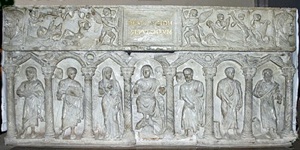


Sarcophagus of the Blessed Giles (4th century AD)
Oratorio di San Bernardino, Perugia
Brother Giles was the third companion to join St Francis, and he was among the group of early Franciscans that accompanied St Francis to Rome in ca. 1209 to secure papal approval for what was to become the Franciscan Order. As a young man, he dedicated himself to itinerant preaching like all of the early Franciscans. St Francis sent him on retreat to a hermitage at Favarone, outside Perugia in 1214: this seems to have marked the beginning of a phase of his lidfe during which he mostly lived in isolated hermitages in Umbria.
After St Francis' death in 1226, Brother Giles continued his eremetical lifestyle. In ca. 1232, he moved to an isolated cell on land in Perugia that belonged to Giacomo di Boncorte Coppoli. Giles’ memories of the early days of the Order are probably contained in a manuscript known as the “Anonymous of Perugia” (ca. 1240), which was discovered in the convent of San Francesco al Prato in 1671. Its author chose not to divulge his name, but confined himself to the fact that he had witnessed the deeds of St Francis and his early brothers, heard their words and become their disciple. Scholars have identified him as Brother John of Perugia, a close associate of Brother Giles.
Brother Giles died in his hermitage in 1262 and Brother John of Perugia followed him to the grave in ca. 1270. Shortly thereafter, Giacomo Coppoli gave the land that contained the early hermitage to the friars of San Francesco al Prato, and some of them settled there. This became the site of the Convento di Monteripido.
Cult of the Blessed Giles
Brother Giles had wished to be buried in the little chapel of the Portiuncula, outside Assisi, but the Perugian Commune posted guards to ensure that his body remained in the city. This was despite the fact that Giles had warned that he would never be canonised and never perform posthumous miracles, quoting the words of Christ: “An evil and adulterous generation asks for a sign, but no sign will be given to it except the sign of Jonah” (Matt: 13, 39).
When an early Christian sarcophagus bearing reliefs of the story of Jonah (illustrated above) was discovered soon after in the Campo d’ Orto (now Piazza San Francesco), this was taken to be a miracle. The earlier occupants were removed from the sarcophagus and it was re-used for Brother Giles, who was buried in San Francesco al Prato. (The later history of his cult is set out on this page on San Francesco al Prato. As described in more detail there, the relics and the sarcophagus are now in the Oratorio di San Bernardino).
Legend of the Blessed Giles
The Franciscan Brother Salimbene de Adam (see reference below) recorded in his “Chronicle” (1283-80) that: “Brother Giles ... lies in a stone tomb in the church of the Brothers [at Perugia]. His life has been written by Brother Leo, one of the three special companions of St Francis”.
-
✴The so-called “longer life” is in the “Chronicle of the Twenty-Four Generals of the Order of Friars Minor”, (paragraphs 74- 115).
-
✴The so-called “shorter life”, which survives in a number of 14th century manuscripts, and been translated by Rosalind Brooke (see below).
Read more:
R. Brooke, "Scripta Leonis, Rufini et Angeli Sociorum Sancti Francisci: the Writings of Leo, Rufino and Angelo, Companions of St. Francis”, Oxford, 1970 contains a translation of the so-called “shorter life” of the Blessed Giles (at pp 318-49)
J. Baird et al. (Trans), “Chronicle of Brother Salimbene de Adam” (1986) Binghampton, New York, p 564
Return to Saints of Perugia.

